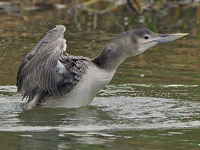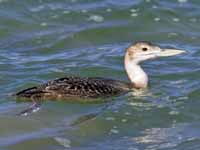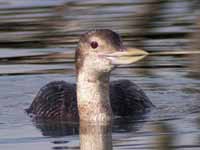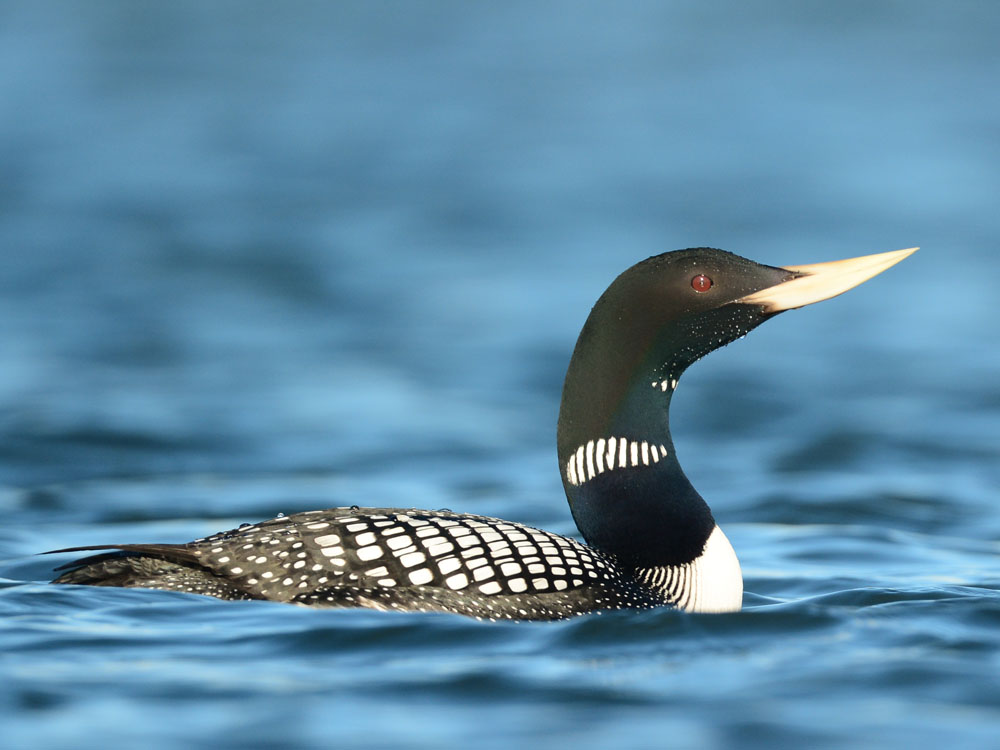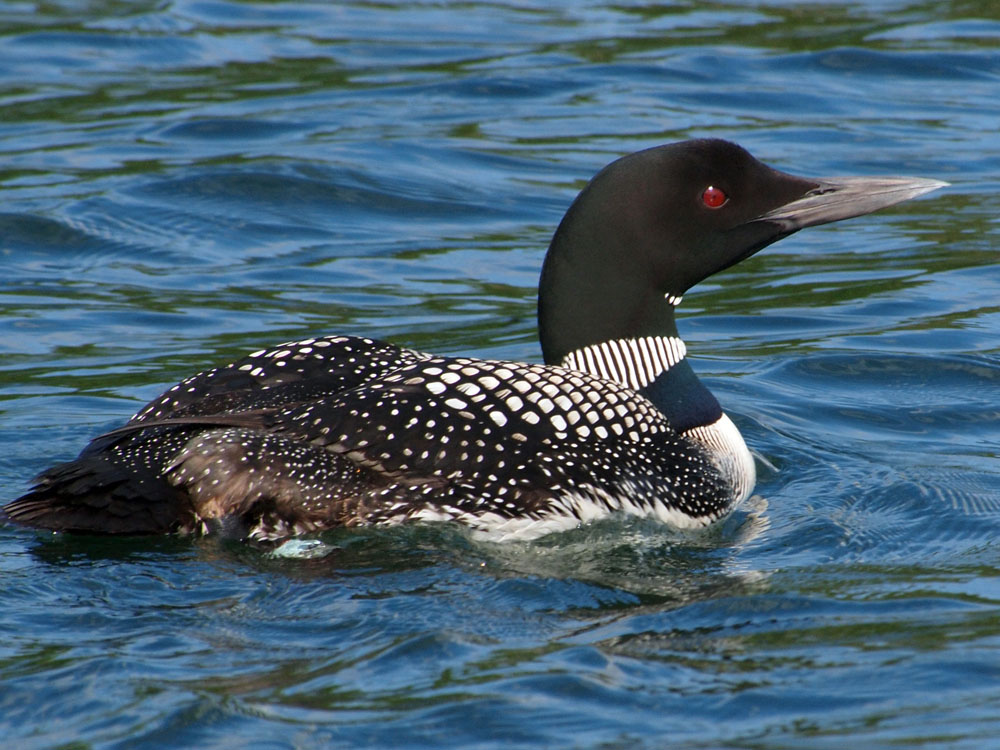Loons are famous for their hauntingly eerie call. The sexes have similar plumage, but the males are larger than the females. They are similar to cormorants and penguins. All of these birds have webbed feet, float low in the water, and chase fish by swimming underwater. The fact that a loon often abruptly dives for fish resulted in the birds being referred to as “divers” in the Old World. To aid their swimming and diving, their legs are located far back on their body. This results in their having great difficulty walking and this clumsy behavior resulted in the birds being termed “loons” in the New World. Grebes also have their legs located far back on their body and they too walk ungainly. To aid in their digestion of food, loons ingest pebbles from lake bottoms to help grind their food. In the past, lead fishing sinkers were also ingested along with the pebbles and that caused a decline in loon population. Fortunately, lead sinkers are now banned.
The bones of loons are denser than all other other flying birds. This extra weight lets them swim low in the water and prevents them from being too buoyant when swimming underwater. However, it does mean that their takeoffs for flying are problematic. Most species need to take off from water and must head into the wind while taking off. There have been instances of lakes freezing suddenly and loons dying because they could no longer take off. Only the red-throated loon, the smallest of the species, can take-off from land.
Loons nest on lakes that are clear so they can easily see fish. The nests are located within a meter of the shore because of the loon's poor walking ability. They prefer sites surrounded by water for protection against predators. They willingly uses artificial islands created by loon lovers. The nest is built by the pair and both share incubation duties. They usually only have two eggs, but may double clutch if none of the chiks survive. Predators such as fox will take look eggs and bald eagles will take chicks. However, the loons are not without defense. They are aggressive with their long thin bills and a common loon has been recorded stabbing a bald eagle to death! The small number of chicks that loons produce each year is somewhat compensated by their long life - up to 30 years. The only species that has a threatened population is the yellow-billled loon and that is because of the taking of eggs by native populations,
The loons have distinct calls that are unlike that of any other bird species.
Genus Gavia
Loon,_Arctic Gavia arctica
Description: The Arctic loon, also known as the black-throated loon, also known as the black-throated diver, has white underparts. The breeding loon has a black back with white bars. It has a black face and black sides of throat with white stripes. The throat is dark green. The nonbreeding loon has grey upperparts and a white throat. It usually has its nest on the ground within a meter of the water or in vegetation that has emerged from the water. The Arctic loon is about 77 cm long. The similar Pacific loon has a more rounded head.
Range: Seward Peninsular in Alaska, northern Eurasia.
Habitat: Breeds in freshwater and brackish lakes. Winters at the coast.
Diet: Mainly fish; also insects, mollusks, crustaceans, and plant matter.
Conservation status: Least Concern.
Image by: 1) Hiyashi Halso 2) Linda Tanner - California
3) Francesco_Veronesi - Finland 4) Steve Garvie - Scotland Range: Seward Peninsular in Alaska, northern Eurasia.
Habitat: Breeds in freshwater and brackish lakes. Winters at the coast.
Diet: Mainly fish; also insects, mollusks, crustaceans, and plant matter.
Conservation status: Least Concern.
1) Juvenile 2) Nonbreeding 2, 4) Breeding
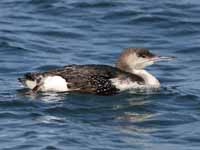



Loon,_Common Gavia immer
Description: The common loon, also known as the great northern diver, has white underparts and red eyes (brighter when breeding). The breeding loon has a black-and-white checkered back and a black head. It has a black neck and a white collar with black stripes. While nonbreeding it has a grey crown and back. The common loon is on Canada's one dollar coin which is affectionately called a loonie. The common loon is famous for its haunting calls. It is between 65 and 90 cm long which makes it the second largest loon species, close to the yellow-billed loon.
The similar Pacific Loon has a thinner bill and while nonbreeding it has more grey on its neck.
The similar red-throated loon also has a thinner bill and nonbreeding has a lighter face.
The similar yellow-billed loon has a yellowish bill.
Range: North America, Europe.
Habitat: Lakes in the breeding season; coastal in the winter. Needs good visibility to see fish.
Diet: Prefers fish, but will settle for crustaceans, aquatic insects, frogs.
Conservation status: Least Concern.
Image by: 2) Dick Daniels - McGee Island, Maine 3) Dick - North Carolina 9) Dick - New Hampshire 7) Elaine R Wilson - British ColumbiaThe similar Pacific Loon has a thinner bill and while nonbreeding it has more grey on its neck.
The similar red-throated loon also has a thinner bill and nonbreeding has a lighter face.
The similar yellow-billed loon has a yellowish bill.
Range: North America, Europe.
Habitat: Lakes in the breeding season; coastal in the winter. Needs good visibility to see fish.
Diet: Prefers fish, but will settle for crustaceans, aquatic insects, frogs.
Conservation status: Least Concern.
1) Juvenile 2) Nonbreeding 3, 4) Breeding
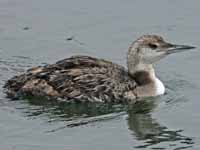
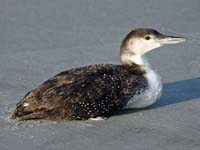
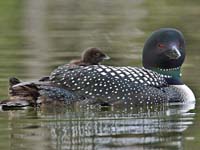
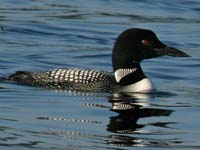
Loon,_Pacific Gavia pacifica
Description: The Pacific loon has white underparts. While breeding it has a black back with white bars and a black face. The sides of the throat are black with white stripes. While nonbreeding it has grey upperparts and a white throat. The Pacific loon is up to 74 cm long.
The similar Arctic loon Loon has white along flanks; Pacific Loon has a more rounded head.
The similar common loon has a thicker bill and nonbreeding has white around the eye.
The similar red-throated loon while nonbreeding has a lighter face.
Range: North America (west coast, Alaska, northwest Canada), Asia.
Habitat: Spends most of the time along the Pacific coast, but breeds on tundra lakes.
Diet: Mainly fish which it catches by diving. Groups of loons may herd fish closer to the surface where they are easier to catch. Pacific loons forage nearer to shore than other loons.
Conservation status: Least Concern.
Image by: 1) Mike's Birds - California 2) Sara Grace - California 3) Tim_Bowman of USFWS
4) Alan
Vernon - California The similar Arctic loon Loon has white along flanks; Pacific Loon has a more rounded head.
The similar common loon has a thicker bill and nonbreeding has white around the eye.
The similar red-throated loon while nonbreeding has a lighter face.
Range: North America (west coast, Alaska, northwest Canada), Asia.
Habitat: Spends most of the time along the Pacific coast, but breeds on tundra lakes.
Diet: Mainly fish which it catches by diving. Groups of loons may herd fish closer to the surface where they are easier to catch. Pacific loons forage nearer to shore than other loons.
Conservation status: Least Concern.
1, 2) Nonbreeding 3, 4) Breeding
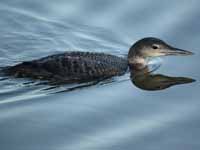
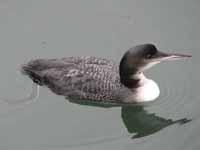

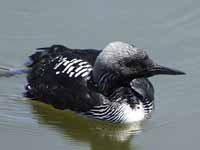
Loon,_Red-throated Gavia stellata
Description: The breeding red-throated loon, also known as the red-throated diver, has brownish-black underparts and a grey head. It has a grey neck with red throat;. The bill is black and pointed. While nonbreeding it has blackish upperparts. The bill is then pale. It has a grey crown, and a grey nape. The underparts and throat are white. It is the smallest of the loons, less than 70 cm.
The similar common loon has a thicker bill and while nonbreeding a darker face.
The similar Pacific loon while nonbreeding also has a darker face and no white behind the eyes.
Range: North America, Europe, Asia.
Habitat: Breeds in arctic and sub-arctic lakes. Winter along both North American coast, European coast, and Asian coast.
Diet: Mainly fish. Also aquatic insects, crustaceans, frogs, plant materials.
Conservation status: Least Concern.
Image by: 1) Dick Daniels - North
Carolina 2) Lin_Sun_Fong - Taiwan 3) David Karna - Iceland 4) Jason Crotty - California The similar common loon has a thicker bill and while nonbreeding a darker face.
The similar Pacific loon while nonbreeding also has a darker face and no white behind the eyes.
Range: North America, Europe, Asia.
Habitat: Breeds in arctic and sub-arctic lakes. Winter along both North American coast, European coast, and Asian coast.
Diet: Mainly fish. Also aquatic insects, crustaceans, frogs, plant materials.
Conservation status: Least Concern.
1, 2 Nonbreeding 3, 4) Breeding
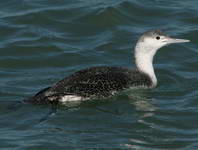
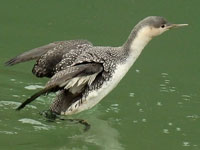
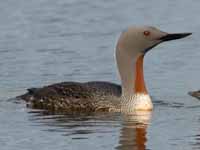
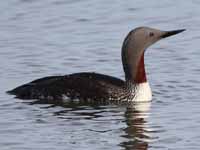
Loon,_Yellow-billed Gavia adamsii
Description: The yellow-billed loon, also known as the white-billed diver, has white underparts. While breeding it has a yellow bill, black head, and a black neck with a black striped white collar. The nonbreeding loon has brown upperparts, nape, and crown. The bill is yellowish and the throat is white. The yellow-billed loon is up to 97 cm long which makes it the largest loon, slightly larger than the common loon. The similar common loon does not have a yellow bill and when nonbreeding it has a darker head.
Range: North America (west coast, Alaska, northwest Canada), Europe, Asia.
Habitat: Breeds in tundra regions of the north, usually on inland lakes near the coast but also hundreds of km inland. During nonbreeding times it is coastal in northern climates, but also scattered across the USA on inland lakes that remain unfrozen.
Diet: Mainly fish; also crustaceans, mollusks
Conservation status: It is listed as Near Threatened, the main problem the taking of eggs by native populations.
Image by: 1) Nik_Borrow 2) Bill Bouton - California 3) Len_Blumin - California 4) Ryan_AskrenRange: North America (west coast, Alaska, northwest Canada), Europe, Asia.
Habitat: Breeds in tundra regions of the north, usually on inland lakes near the coast but also hundreds of km inland. During nonbreeding times it is coastal in northern climates, but also scattered across the USA on inland lakes that remain unfrozen.
Diet: Mainly fish; also crustaceans, mollusks
Conservation status: It is listed as Near Threatened, the main problem the taking of eggs by native populations.
1) Juvenile 2, 3) Nonbreeding 4) Breeding
